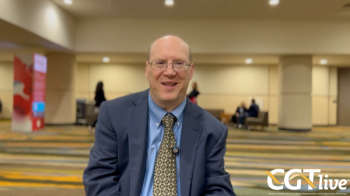
Gene Therapy Stabilizes Neurocognition, Reduces CSF D2S6 in MPSII
Paul Harmatz, MD, professor, UCSF, discussed benefits in neurocognitive outcomes and ERT therapy usage after RGX-121 gene therapy for Hunter syndrome.
Data from REGENXBIO’s pivotal phase 1/2/3 CAMPSIITE clinical trial (NCT03566043) assessing RGX-121 in patients with severe neuronopathic central nervous disease in mucopolysaccharidosis type 2 (MPSII), also known as Hunter syndrome demonstrated that the therapy reduced cerebrospinal fluid (CSF) levels of D2S6 compared with baseline (P = .00016), meeting the trial’s primary endpoint.
Data from CAMPSIITE were presented by Paul Harmatz, MD, pediatric gastroenterologist and professor in residence at University of California at San Francisco (UCSF), at
CGTLive: What effect did RGX-121 have on neurocognitive outcomes?
Paul Harmatz, MD: We showed the sum of the neurocognitive outcomes over time and focused in this study on the Bailey infant panel that looks at development in this age group. Cognitive is one of the components that we looked at. Notably, some patients start above minus 2 standard deviations, so they qualify for being in the normal range, and some start below minus 2 standard deviations. They tend to be younger when they're in the normal range, they are older, in general, when they start below. For the group that starts within the normal range, most continued to follow development of cognitive outcomes within the normal range, with up to 4 years for the earliest patients. The goal of these studies is to maintain normal development and skill acquisition group that falls below the normal range. The majority either were stable or showed gain. So, it still can be a benefit. Certainly in the more affected patients, if you quiz families, my impression is that their goal for these studies is to maintain function at the level that you entered the study, they would love to see improvement, but they know that this is a neurodegenerative disease that will over 10 to 20 years be really severe and cause complete loss of function and death in the second decade.
What dose-dependent responses were seen on D2S6 CSF reduction?
Harmatz: For part 2, we recruited 10 more patients. The study format was quite similar with except the primary time point for looking at D2S6 was 16 weeks. The goal was to have a majority of the patients to fall from their high D2S6 to the attenuator branch. Eight of the 10 met that endpoint, the ninth was very close with an 80% drop, and the tenth had a 55% drop. So even not breaching the attenuated range, they still had very significant responses. Safety is also an important outcome. We saw safety going out 1 year in both studies, which is very good. In part one, no serious adverse events (SAE) were related to the injection procedure, which is cisterna magna injection as the primary method and then intraventricular injection secondary. In the pivotal phase, there was one SAE that was related to elevated liver function which resolved with steroids. AEs were related either to disease or some side effect of the immunosuppression that we use during studies.
How did RGX-121 therapy affect ERT usage?
Harmatz: That is our third really important area that we looked at and was pretty remarkable. In dose groups 2 and 3 from part 1/2 of the study, 70 to 80% of the patients either started naive, and were able to stay naive, or started on ERT and went off of it at the agreement of investigators and families. Between those groups, we were able to keep 70 to 80% off of ERT. The criteria for going back on is a doubling of the GAG at the level when we start withdrawal. So, this is really significant, it saves the weekly time commitment to ERT, the risks of having a mediport if they are not able to have enzyme therapy, they don't need to have an access that has a risk of infection. It also saves a great deal of money that is invested in enzyme therapy. Theoretically, your immune system is much more likely to not have antibodies if it's seen a constant supply of enzyme rather than a pulse delivery that we use for ERT. So, the hope is they won't develop antibodies to the enzyme or they will disappear if we stop ERT. This is theoretical but hopefully will be looked at overlong-term studies.
Lastly, the drug appears to have a long lifespan of up to 4 years so far. It does show a dose response to all doses and moves the patient into the attenuated range - the highest dose actually reaches almost just above normal range. We're able to withdraw 70 to 80% of the patients or keep them off ERT and neurocognition looks really good if you can start early. Now with newborn screening in place, our hope is that this will be the breakthrough, we need to start patients in the first year of life and see an optimal outcome. The pivotal study met its endpoint, and this was sort of the composite that we really needed to move forward, out of the early phase into a later development phase. We're excited.
Transcript has been edited for clarity.
REFERENCE
Harmatz P, Ficicioglu C, Giugliani R, et al. CAMPSIITE™ phase I/II/III: An interim clinical study update of RGX-121, an investigational gene therapy for the treatment of neuronopathic mucopolysaccharidosis type II (MPS II). Presented at: 2024 WORLDSymposium; February 4-9; San Diego, California. Abstract #135
Newsletter
Stay at the forefront of cutting-edge science with CGT—your direct line to expert insights, breakthrough data, and real-time coverage of the latest advancements in cell and gene therapy.

















































